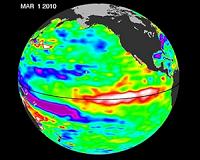| . |  |
. |
Geneva (AFP) March 30, 2010 Weather experts said Tuesday that El Nino, the weather anomaly that wrecks havoc around the Pacific and east Africa, has peaked and would disappear by mid-year. "The most likely outcome by mid-year 2010 is for the El Nino event to have decayed and near-neutral conditions to be re-established across the tropical Pacific," said the World Meteorological Organisation expert Rupa Koumar Kolli. El Nino is an occasional seasonal warming of the central and eastern Pacific Ocean that upsets normal weather patterns from the western seaboard of Latin America to east Africa. According to the UN weather agency, the climate phenomenon may have peaked in November or December. However, its effects should still be felt through April to June. "This is because impacts on many climate patterns both close to and remote from the Pacific, can occur even during the decay phase of an El Nino event." Kolli said that this year's El Nino had a major impact in extreme climate events such as monsoons in southeast Asia and drought in southern Australia. In February, the Philippines warned that its farming industry could lose about 433 million dollars due to a drought caused by El Nino. Meanwhile in the Americas, El Nino was blamed for blizzards in the United States, heatwaves in Brazil, killer floods in Mexico and drought in Ecuador which occurred in February.
Share This Article With Planet Earth
Related Links El Nino, La Nina and an Ocean called Pacifica
 The Last Hurrah For El Nino 2010
The Last Hurrah For El Nino 2010Pasadena CA (JPL) Mar 22, 2010 El Nino 2009-2010 just keeps hanging in there. Recent sea-level height data from the NASA/European Ocean Surface Topography Mission/Jason-2 oceanography satellite show that a large-scale, sustained weakening of trade winds in the western and central equatorial Pacific during late-January through February has triggered yet another strong, eastward-moving wave of warm water, known as a Kelvin wave ... read more |
|
| The content herein, unless otherwise known to be public domain, are Copyright 1995-2010 - SpaceDaily. AFP and UPI Wire Stories are copyright Agence France-Presse and United Press International. ESA Portal Reports are copyright European Space Agency. All NASA sourced material is public domain. Additional copyrights may apply in whole or part to other bona fide parties. Advertising does not imply endorsement,agreement or approval of any opinions, statements or information provided by SpaceDaily on any Web page published or hosted by SpaceDaily. Privacy Statement |